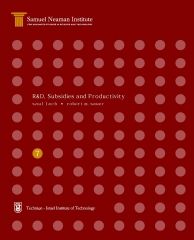In this paper we formulate a model that extends the traditional theoretical literature on the optimal management of an R&D project by emphasizing the model’s empirical and policy implications. We solve the firm’s dynamic problem and use the resulting optimal R&D policy to assess the role of subsidies aimed at stimulating R&D activities.
The theoretical framework illustrates that the sign and size of the “additionality effect” the change in the amount of company-financed R&D caused by the subsidy depends on the model’s parameters and distributional assumptions. It is, therefore, an empirical matter. The model also provides a framework for interpreting anew the empirical association between R&D expenditures and productivity growth found in many micro-level productivity regressions.












